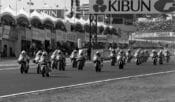Indisputably Intuitive
We test KTM’s first-ever parallel-twin
KTM has made a key roll of the dice with the introduction of the 790 Duke, its first-ever parallel-twin, powered by the all-new LC8c (standing for liquid-cooled eight-valve compact) engine.
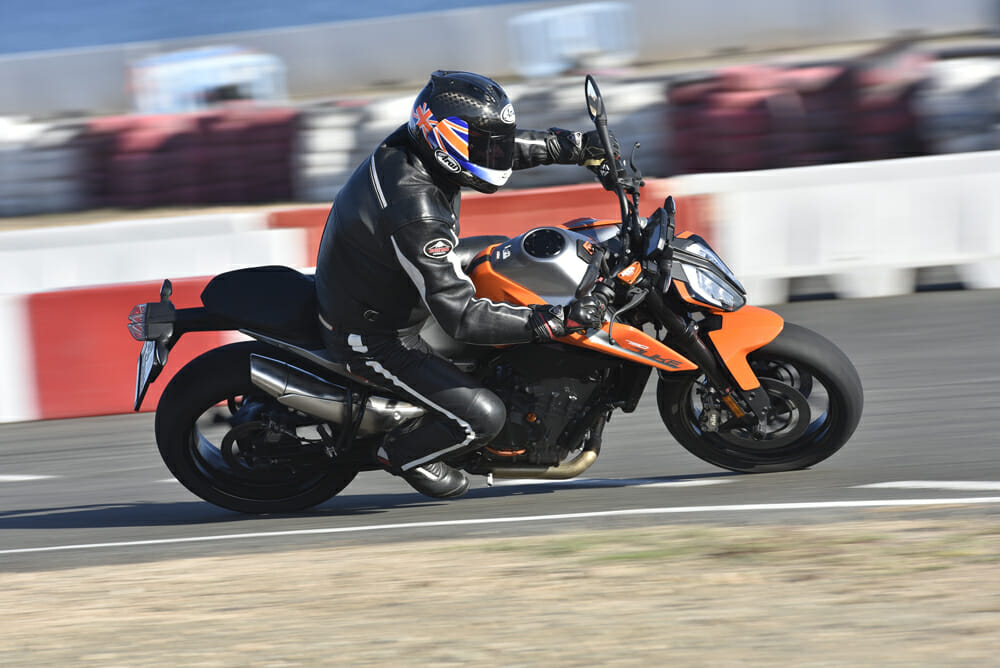
Previously, KTM had only its 690 Duke single-cylinder niche model to compete in the significant segment that is the middleweight marketplace. Now, with the 790 Duke twin—aka “The Scalpel,” on account of its focused design and pared-to-the-minimum weight and bulk—KTM has a mainstream contender for marketplace supremacy, making this a vastly important bike for the company that’s both competitively priced, and highly distinctive. What’s more, in transferring production of this and all other future middleweight KTM—and Husqvarna—models powered by the LC8c engine to China in 2020, KTM president Stefan Pierer will ensure that the 790 Duke, its forthcoming 790 Adventure due in a year’s time, and other later models will be all even more affordable.
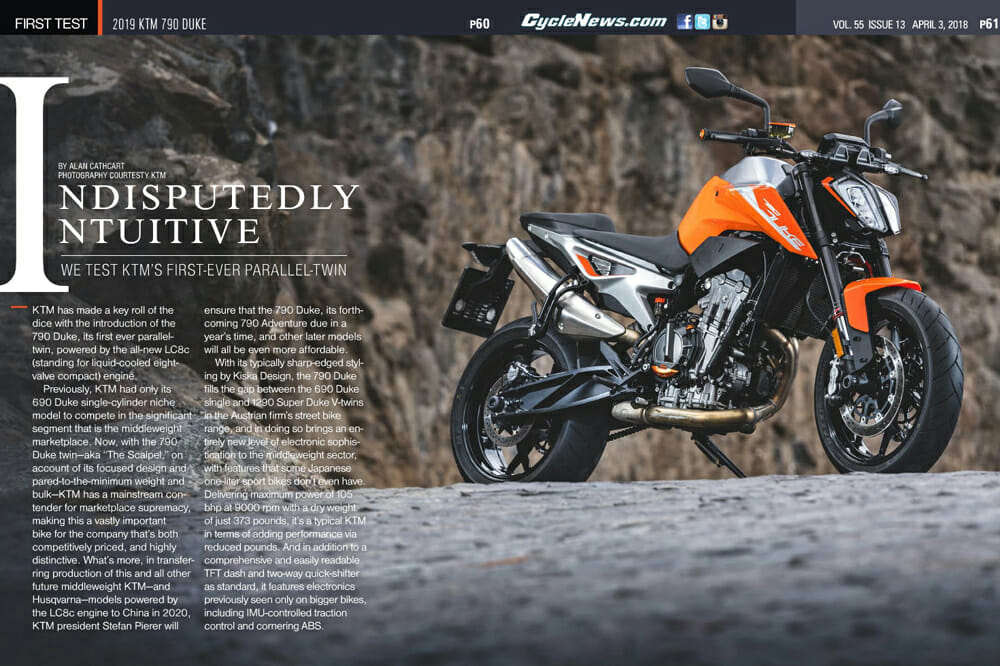
Click here to read this in the Cycle News Digital Edition Magazine.
PHOTOGRAPHY COURTESY OF KTM
With its typically sharp-edged styling by Kiska Design, the 790 Duke fills the gap between the 690 Duke single and 1290 Super Duke V-twins in the Austrian firm’s street bike range, and in doing so brings an entirely new level of electronic sophistication to the middleweight sector, with features that some Japanese one-liter sport bikes don’t even have. Delivering maximum power of 105 bhp at 9000 rpm with a dry weight of just 373 pounds, it’s a typical KTM in terms of adding performance via reduced pounds. And in addition to a comprehensive and easily readable TFT dash and two-way quick-shifter as standard, it features electronics previously seen only on bigger bikes, including IMU-controlled traction control and cornering ABS.
KTM engineers began work on creating the LC8c motor back in 2012, since when the 250 people engaged with the project in the R&D department invested 111,111 man-hours with 60 of them working full time on it, covering 375,692 miles of intensive dyno testing and over 560,000 on the open road. KTM doesn’t do things by halves, but even so, the fact that they invested so much time and money in getting this platform right is an indication of the importance of the project to the company’s future growth strategy.
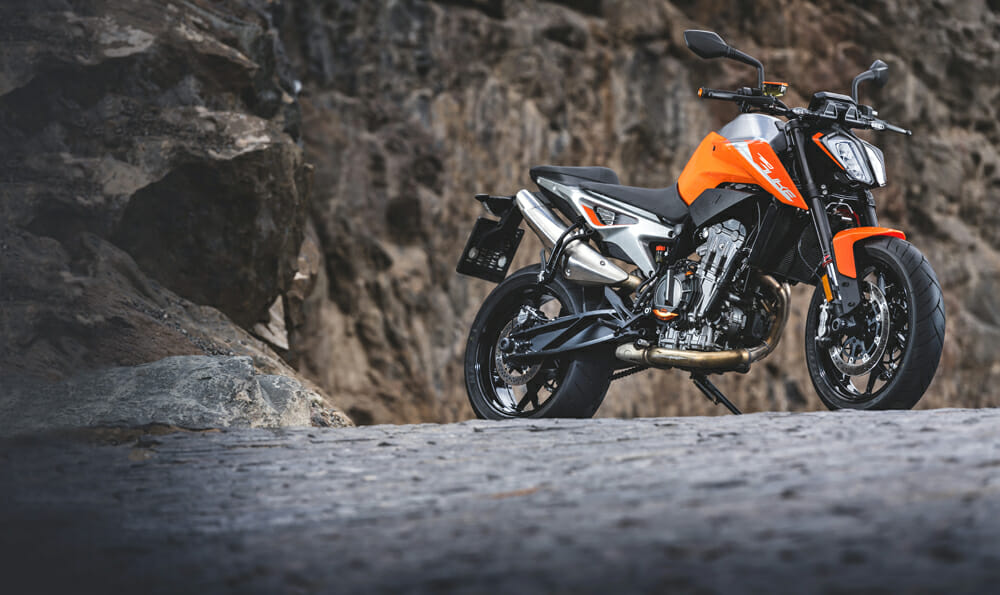
First, though, they spent two years considering whether to produce a downsized middleweight version of their larger capacity 75° V-twin family of engines, before settling on a DOHC eight-valve parallel-twin. “We had to get this right, because it will be such an important platform for us for many years to come,” says Torsten Gaul, the Austrian firm’s head of engine R&D. “But after spending lots of time assessing the two formats, it was pretty clear that the V-twin configuration would not work for us, because our main goal was to get the engine as compact as possible. With the V-twin you have limitations regarding the seat height, because the rear cylinder sticks up into the seating area, and the engine is also longer, which means you must have a shorter swingarm for the same wheelbase, whereas we wanted a longer one for better grip. Also, the height of the engine with the throttle bodies between the Vee also brings disadvantages for packaging reasons, so we decided to go with the parallel-twin format.”
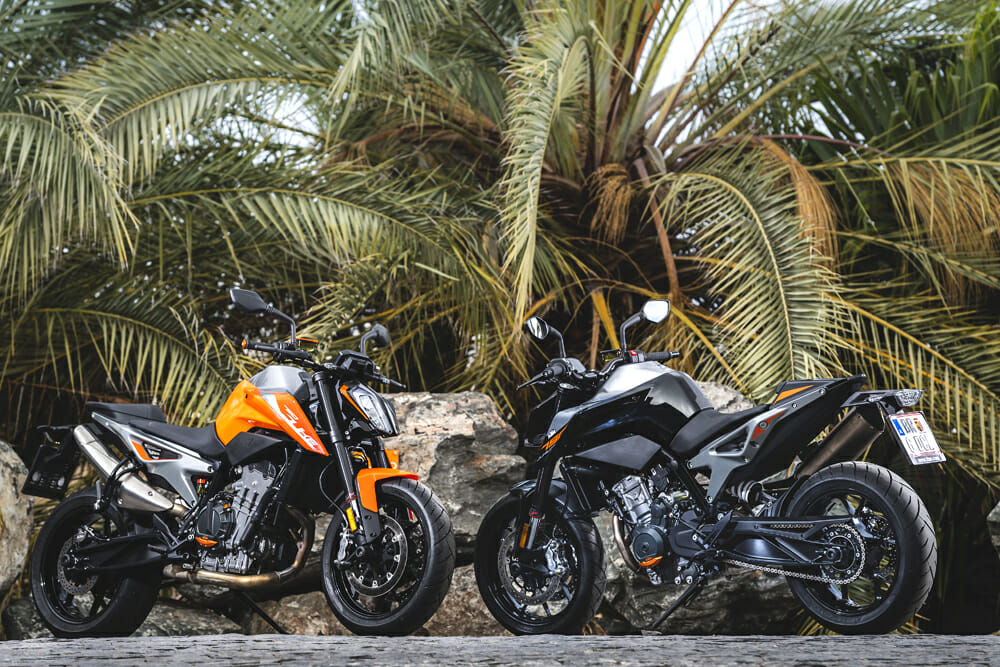
KTM paid special attention paid to keeping the 88 x 65.7mm 799cc motor not only light, but also narrow to help maximize cornering clearance, as well as to suit riders of all heights. “We wanted to make a bike that’s intuitive to ride, that’s light and responsive with the extra performance of a twin, but without sacrificing the agility of a single,” says LC8c Product Marketing manager Adriaan Sinke. Then to go with the firm’s Ready to Race philosophy they wanted to establish a visual link with their motocross bikes, so all of this meant the parallel-twin concept won out. The fact that it also centralizes the mass of the engine, which allowed its engineers to design a more compact, easier-handling motorcycle, was also a key factor.
The result is a compact, lightweight, liquid-cooled DOHC eight-valve engine with its crankpins offset by 75° with 435° firing intervals to replicate the gritty sound of a KTM V-twin’s irregular firing order, fitted with twin counterbalancers to eliminate vibration—one at the front of the engine and one in the cylinder head. These allow the LC8c motor to be employed as a stressed member of the frame, which in KTM tradition is made from tubular steel, with a die-cast aluminum rear subframe and an “inside-out” swingarm operating the non-adjustable (except for spring preload) direct-action cantilever WP shock giving 5.9 inches of travel, matched up front by a 43mm upside-down WP fork that’s equally devoid of adjustment, but gives 5.5 inches of travel.
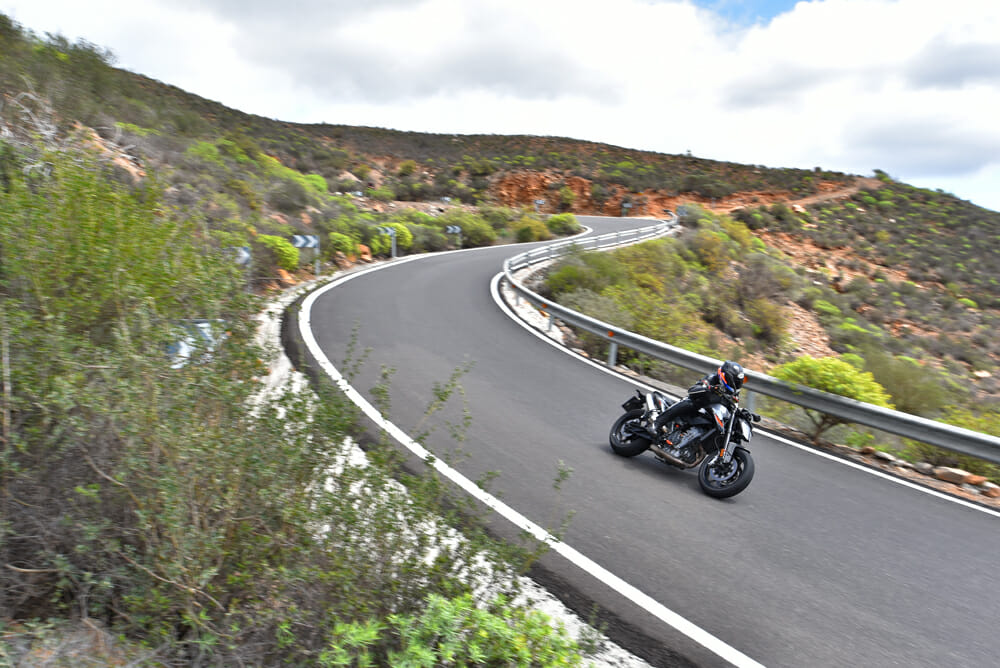
The LC8c is tuned as much for midrange torque as top-end power, peaking with 86Nm at a relatively high 8000 rpm for a parallel-twin, but there’s a broad spread throughout the rev range, with more than 80Nm available at 6000 rpm. There’s chain drive to the cams offset to the right of the cylinders, while the six-speed gearbox allows clutchless quickshifting both up and down the well-chosen ratios, and is matched to a PASC/Power Assisted Slipper oil-bath clutch which is cable-operated for ease of maintenance, and to save weight. The entire very compact engine weighs just 110 pounds without throttle bodies or oil (116 pounds with those included), says Torsten Gaul, compared to 88.2 for the 690 Duke’s single-cylinder motor on the same basis.
That’s pretty amazing for an 800cc twin-cylinder engine, and you definitely feel the result when riding the bike. After being honored with a brief getting-to-know-you ride last September on the prototype 790 Duke, the chance to spend a whole day on the grippy roads of Gran Canaria, including a couple of hours riding the island’s Maspalomas circuit allowed a more intensive evaluation. Just as first time around, though, the 790 Duke feels small, slim, short and sporty, with a close-coupled riding stance that has your chin seemingly over the front wheel. It’s a responsive, eager-revving bike that’s not only thoroughly practical but also hugely entertaining, and totally intuitive to ride. It’s one of those bikes where you feel a part of it from the very moment you hop aboard—this could make riding to work a lot of fun, though maybe not half as much as taking the long way home on it.
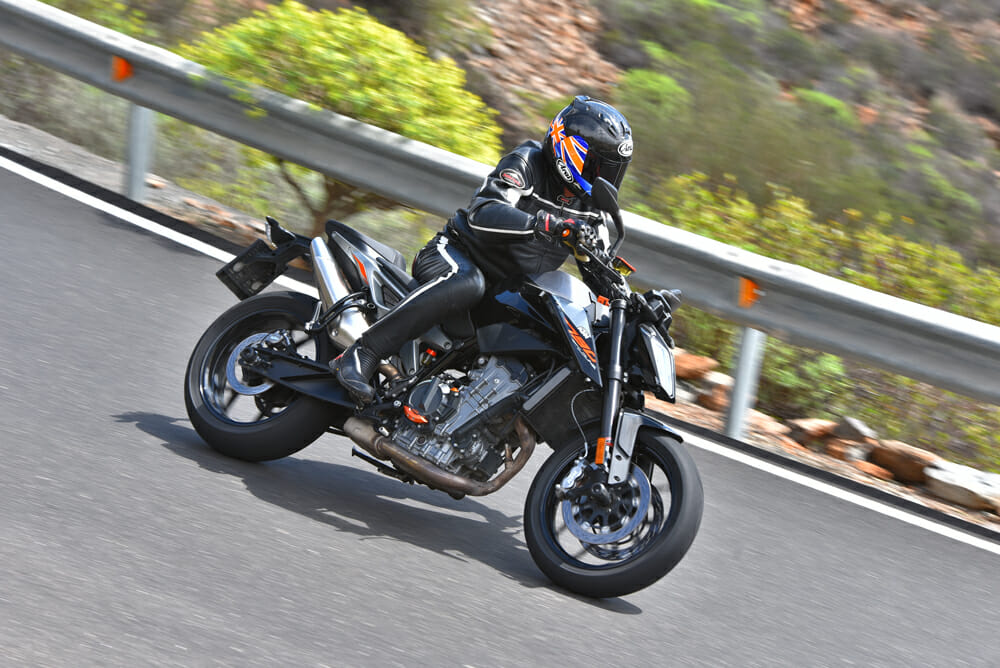
I started out using Street mode out of the four available, before switching to the slightly sharper but still super controllable Sport map—there’s also a Rain mode with a smoother pickup and, reduced power, plus Track which is sharper still for racetrack use, though even that has a crisp but controlled pickup from a closed throttle that’s not at all snatchy. The LC8c motor pulls cleanly wide open from 3000 rpm upwards, with a crisp throttle response in both Street and Sport—I ended up using Sport all day even in traffic and tight, twisting mountain roads. It pays to surf that flat torque curve, so short-shifting wide-open at 7000 rpm rather than the 9500 rpm redline gives you plenty of acceleration en route to 100 mph on the TFT dash, with the prominently marked gear selected reading always readily viewable at a quick glance. Vibration was never an issue at any revs en route to a top speed of about 140 mph, though Torsten Gaul admits his team deliberately left in just enough to give the engine some character—which it has aplenty. The two-way powershifter is superb, delivering light, positive wide-open gearshifts under acceleration, and equally positive downward clutchless shifts accompanied by a great-sounding autoblipper. I didn’t miss a single gear in a 140-mile day of riding.
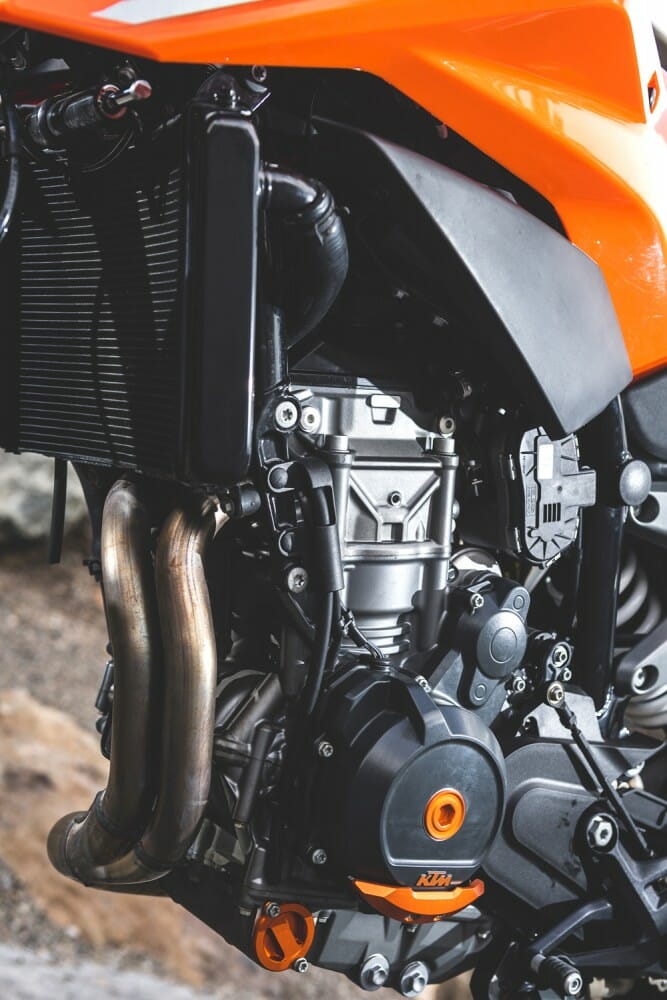
The 790 Duke’s steering geometry is pretty steep, with 24° of rake and 3.9 inches of trail, delivering a 58-inch wheelbase and that’s probably the reason for KTM to fit a non-adjustable WP steering damper behind the lower triple clamp. But the Duke’s agile, super-responsive handling is the payoff for that, coupled with total stability on fast third or fourth-gear turns—it feels planted to the tarmac, yet the great leverage from the wide, taper-section 30-inch aluminum handlebar lets you carve corners and especially switch direction in fast chicanes like the one at Maspalomas really easily. Like I said, it’s intuitive. That handlebar can be adjusted almost infinitely in search of your preferred riding position—in addition to four different clamping positions offered by the upper triple clamp’s design, you can also rotate the ’bar through three different angles to get comfortable with it. Then as well as the stock 32.5-inch seat height, there’s also a lower 31.7-inch seat option available for the extensive KTM aftermarket catalogue, or you can reduce it still further to 30.7 inches via a lowering kit.

Even though KTM has obviously aimed to keep costs down with the non-adjustable WP suspension, the generous travel is well controlled in everyday use, and after a day spent trying my best to fault their choices, I must admit that KTM’s development team got their settings for it just right. I’d never ridden on Maxxis tires before I tried out the 790 prototype, but the Taiwanese manufacturer whose products equip most of KTM’s off-road range has done a good job here with their Supermaxx SP street rubber especially designed to equip the 790 Duke equipping the lightweight 17-inch cast aluminum wheels. The 180/55ZR17 Maxxis rear tire will be another factor in the nimble handling, too.
The twin 300mm front discs are gripped by four-piston radial calipers from Spanish company J.Juan, and these stop the bike well with lots of feel, without using the large 240mm rear disc very hard at all. The settings for the slipper clutch have just enough engine braking left dialed in to help you stop for a second-gear hairpin from high speed, without chattering the rear wheel on the overrun. Plus the settings for the clutchless autoblipper are so ideally chosen that you hardly have to use the brakes climbing a twisty mountain pass—just backshift a couple of times for a slow bend, and the residual engine braking invariably takes care of slowing the bike in normal use. Okay, start going for it, and you need to work the lever, but not otherwise. The clutch action is super light and positive when you do have to use it. This won’t cramp up your left hand riding the 790 Duke to work each morning.
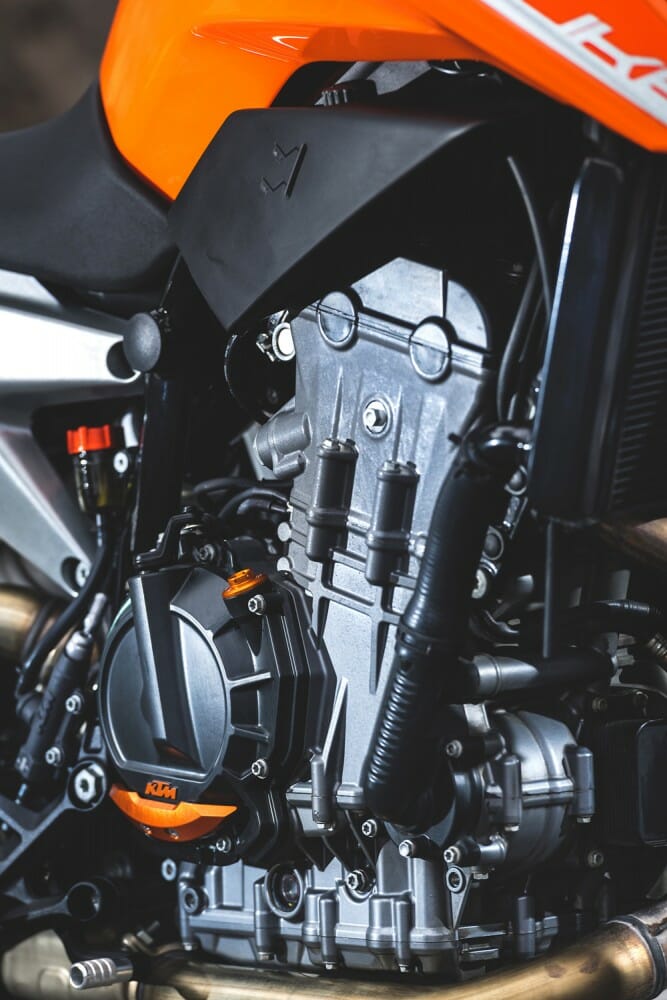
Even braking hard at the end of the Maspalomas main straight after enjoying the extra performance of the street-legal Akrapovič silencer available as an option fitted to the bike I was riding there, the 790 Duke remained stable and well-controlled, and the Maxxis front tire was hard to fault. The Bosch 9.1MP ABS did activate occasionally, but after proving to myself that it did cut in, though not too intrusively, I switched it off as you can do in Track mode only. The non-adjustable suspension didn’t misbehave too much, and you have plenty of warning when the tires started to approach their limits.
KTM is planning a series of 790 Duke Power Cup one-make road racing series around the world, and I can’t think of a better bike for everyone from newbies to returnees and everyone in between to go and have a weekend of fun aboard, trading elbows on track and revving each other up in the bar at the end of the day. In 100% stock street mode the 790 Duke can be ridden pretty hard in something approaching anger without misbehaving, and it totally fulfills the expectations that something painted orange brings to the party—and at a relatively inexpensive price. Ready to Race, indeed. Chris Fillmore will ride a 790 Duke this year in attempting to double-up on his 2017 Pikes Peak victory gained on a 1290 Super Duke. Don’t bet against him nudging his own track record on the big KTM aboard this Little One That Can!
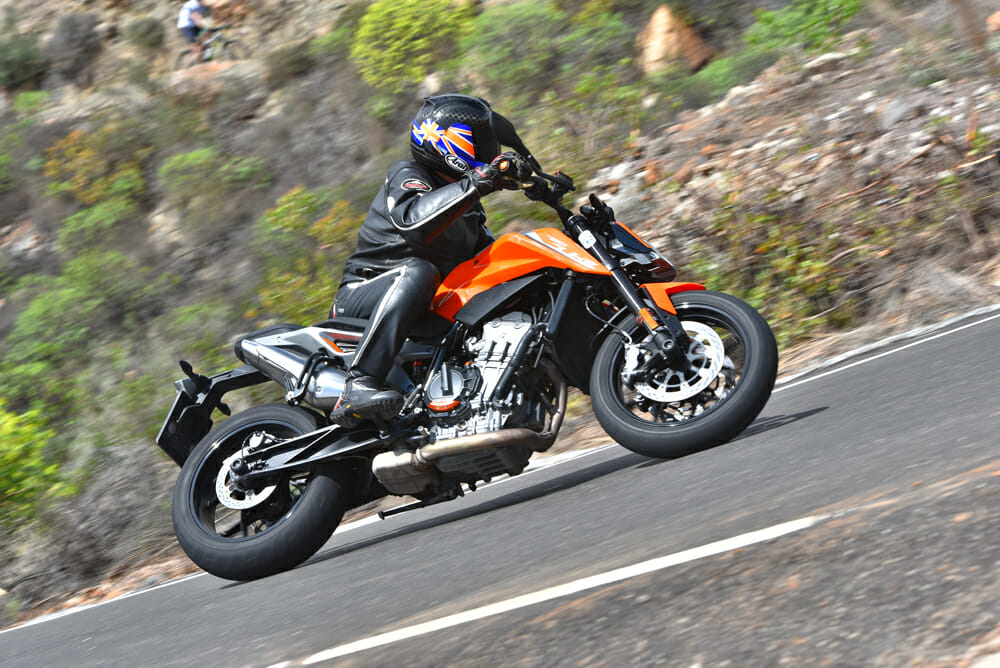
The 790 Duke is a very good motorcycle that sets the bar higher for its rivals in that crowded middleweight category, and it’s in every way a true KTM, replete with the brand’s core values. This is a very impressive real-world ride. CN
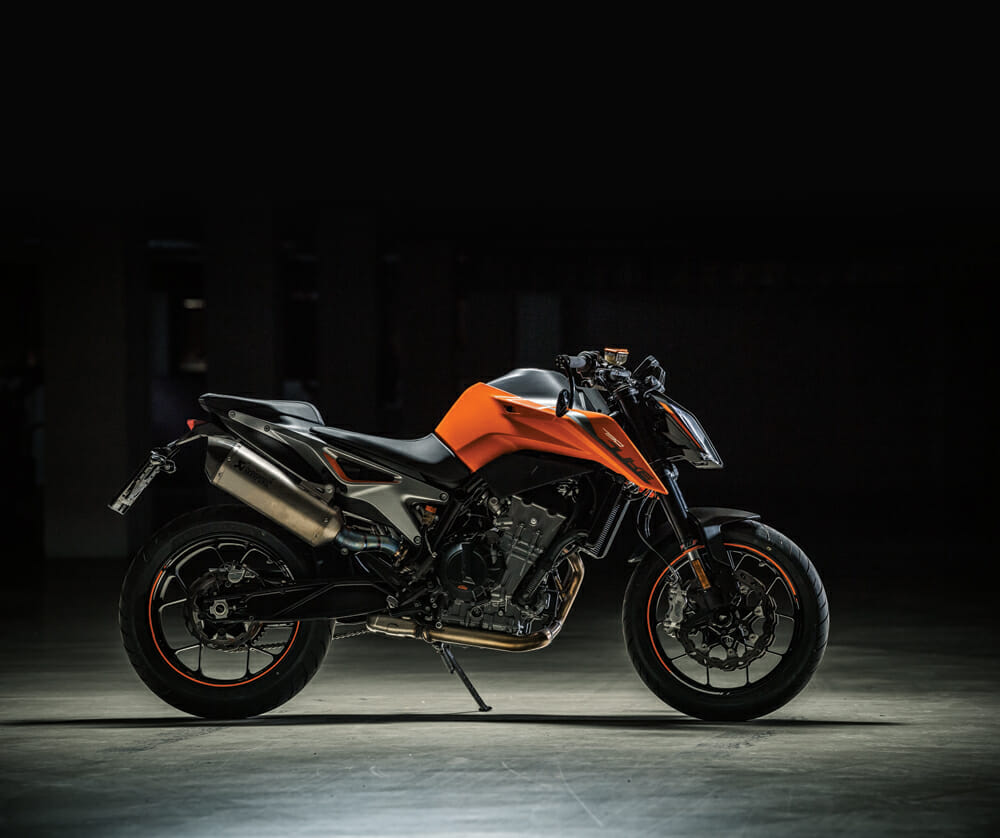
|
SPECIFICATIONS |
|
|
2019 KTM 790 Duke |
(MSRP: TBA) |
|
ENGINE: |
Liquid-cooled, 4-stroke, DOHC, parallel twin |
|
DISPLACEMENT: |
799cc |
|
BORE X STROKE: |
88mm x 65.7mm |
|
HORSEPOWER: |
77 kW (105 hp) @ 9000 rpm |
|
TORQUE: |
87 Nm @ 8000 rpm |
|
COMPRESSION RATIO: |
12.7:1 |
|
TRANSMISSION: |
6-speed |
|
FUEL SYSTEM: |
DKK Dell’Orto (42mm throttle body) |
|
LUBRICATION: |
Pressure lubrication with 2 oil pumps |
|
PRIMARY DRIVE: |
39:75 |
|
FINAL DRIVE: |
16:41 |
|
CLUTCH: |
Cable-operated PASC |
|
EMS: |
Bosch EMS with RBW |
|
TRACTION CONTROL: |
MTC (3-mode + Track, disengage) |
|
FRAME: |
Chromium-Molybdenum-Steel w/engine as stressed element |
|
SUBFRAME: |
Aluminum |
|
HANDLEBAR: |
Aluminum, tapered |
|
FRONT SUSPENSION: |
WP-USD 42mm |
|
REAR SUSPENSION: |
WP single shock |
|
FRONT WHEEL TRAVEL: |
5.5 in. |
|
REAR WHEEL TRAVEL: |
5.9 in. |
|
FRONT BRAKE: |
2 radially mounted 4-piston calipers, 300m discs |
|
REAR BRAKE: |
2-piston caliper, 240mm single disc |
|
ABS: |
Bosch 9.1 MP (incl. cornering ABS and Supermoto ABS, disengageable) |
|
FRONT WHEEL: |
120 70 ZR 17 in. |
|
REAR WHEEL: |
180/55 ZR 17 in. |
|
CHAIN: |
X-Ring 520, 5/8 x 1/4” |
|
SILENCER: |
Stainless-steel primary and secondary silencer |
|
STEERING HEAD ANGLE: |
66° |
|
TRAIL: |
3.9 in. |
|
WHEELBASE: |
58.1 in. |
|
GROUND CLEARANCE: |
7.3 in. |
|
SEAT HEIGHT: |
32.5 in. |
|
FUEL CAPACITY: |
3.1 gal. |
|
DRY WEIGHT (claimed): |
373 lbs. |
|
WET WEIGHT (claimed): |
384 lbs. |
Click here to read this in the Cycle News Digital Edition Magazine.
Click here for more KTM motorcycle reviews and news.
Click here for the latest Cycle News Sportbike motorcycle reviews and news.
